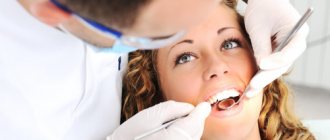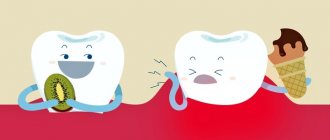Many patients ask dentists: should teeth be a little loose or does this indicate some kind of disease? Some mobility of dental units is observed normally, but it is very small and usually not noticeable. If a person’s teeth are noticeably loose and we are not talking about milk teeth, which should soon be replaced, it is necessary to find the cause of their mobility and eliminate it. Why do teeth become loose in adults, how to treat this pathology and what should be done in this case?
Symptoms
In the vast majority of cases, teeth become loose due to advanced caries and the presence of tartar. Clear signs that you will experience periodontal problems in the coming months:
- dark spots on tooth enamel;
- bleeding gums;
- high sensitivity of teeth to cold/hot;
- pain when chewing.
At the initial stage, the amplitude of tooth loosening does not exceed 1 mm. Subsequently, it increases, and the tooth wobbles in all directions. Biting or chewing with it is uncomfortable or even impossible.
Periodontal diseases are most often accompanied by atrophy of the jaw bone. That is, the volume of bone tissue in which the teeth are anchored gradually decreases. This is clearly noticeable by the “sagging” of the gum line, the formation of gum pockets and the increasing exposure of the necks of the teeth. If no measures are taken, bone volume can decrease catastrophically, leading to loose teeth. And this already threatens their loss.
How does a baby tooth change to a permanent one?
Adults usually no longer remember their sensations when changing teeth when this process begins in their children. Hence the excitement. Parents feel that their child is in pain and uncomfortable when a baby tooth becomes loose. However, often the loss of baby teeth is completely painless.
Every child has the rudiments of molars under the baby teeth at birth, and they continue to form in all subsequent years. When the time comes, the baby tooth must let the permanent one through, making its way up through the gums. The roots of baby teeth begin to dissolve several months before the tooth becomes loose. When it wobbles, it means that the roots are no longer there, only the gums hold it in place. And a new, permanent tooth is on the way.
What do we have to do
You don't need to do anything special. You can gently loosen the tooth little by little - the child can do this on his own, remembering to wash his hands first. You should not forcefully pull out a tooth with your fingers or deliberately bite hard objects - this can injure the gums and cause infection.
Be sure to warn your child about what is happening and make sure he doesn't accidentally swallow the tooth when it finally falls out. This is a good time to talk about the Tooth Fairy (Mouse, Squirrel). Then he himself will strive to say goodbye to the old milk tooth as quickly as possible.
When a visit to the doctor is necessary
If a baby tooth begins to loosen on time, but does not fall out for a long time, it needs to be removed. The problem is that a permanent one has probably already broken through underneath it. If you don't make room for it, it will begin to grow crookedly.
In addition, sometimes the child's temperature may rise. If it does not subside for more than three days, or is accompanied by nausea and vomiting, you should see a pediatrician.
There are also other situations when you should not wait for a loose baby tooth to fall out on its own and you need to remove it. Do not delay visiting the dentist if:
- The baby tooth has been loose for a long time and greatly interferes with chewing food;
- the tooth is broken and its sharp edges touch the oral mucosa or tongue;
- the tooth or its root is severely damaged by caries (this can lead to damage to the permanent tooth);
- the tooth is affected by pulpitis, gum inflammation or a cyst has occurred.
If the situation repeats itself - that is, the teeth begin to loosen, but do not fall out on their own, especially if the erupting permanent teeth are already clearly visible underneath them, you should undergo additional tests. Most likely, your child has excess calcium in the body. This is just as bad as its deficiency; nutritional adjustments are necessary.
If baby teeth begin to loosen too early - for example, at 2 or 3 years - you should contact a dentist immediately. This is not a sign of a natural, physiological process. This is a signal of a serious illness that requires urgent treatment. Teeth become loose due to pathologies such as:
- periodontal disease;
- hereditarily weak gums;
- rickets;
- vitamin deficiency or anemia;
- diabetes.
Today, all of them can be successfully treated, even in young children - but subject to timely diagnosis and compliance with all doctor’s instructions. The health and quality of your child's future life may depend on how quickly you react.
Teeth started to loosen: what to do?
The sooner you go to the dentist, the greater the chance of saving the tooth. The doctor will suggest taking a targeted or panoramic X-ray, depending on how many teeth are loose. They can be used to determine the degree of periodontal damage and bone loss.
Before starting treatment, it is necessary to carry out professional oral hygiene - clean the teeth (including under the gums) from hard deposits (tartar) and bacterial plaque. This is a standard procedure performed with an ultrasound machine. Ideally, such cleaning should be carried out once every six months.
If necessary, the patient also undergoes systemic diagnostics and consults with specialized doctors. Further treatment depends on how loose the teeth are and what the causes of the loosening are.
Caries
In childhood, caries develops at a high rate, spreading to neighboring teeth. However, it may not be visible from the outside. Teenage teeth continue to form for several more years, and their enamel is very thin and does not protect well from microbial plaque. That is why a child’s permanent teeth are no less susceptible to caries than baby teeth.
Systemic diseases
Teeth in children can become loose due to systemic diseases in the body, when metabolism and blood supply to tissues are disrupted.
These include:
- thyroid diseases;
- diabetes;
- genetic diseases;
- skin diseases.
All of them lead to degeneration of oral tissues, which leads to tooth mobility.
What will the doctor do if the tooth is loose?
In modern dentistry, tooth-preserving methods are practiced, so a tooth is removed only if it is very loose and cannot be restored. When an adult’s teeth become loose, treatment depends on the causes and course of the pathological process.
If the loosening is still minor and is caused by weakening of the gums, it is necessary to clean the periodontal pockets from bacterial deposits. For this purpose, therapy is carried out using the Vector device. The doctor directs a healing mixture into the pockets, which acts simultaneously with ultrasonic vibrations and effectively cleanses the teeth down to the roots. The procedure is painless and promotes gum healing. Also, many dentists use lasers for the same purposes.
After this, the doctor prescribes therapeutic treatment:
- applications with antiseptic drugs;
- applying medicinal gels to the gums that relieve inflammation and restore tissue;
- strengthening gums with rinses - herbal infusions (aloe, oak bark);
- taking vitamins;
- gum massage, which needs to be performed 3-4 times a day on your own;
- if there is inflammation with purulent discharge, the dentist will recommend antibiotics.
In severe cases of periodontitis, when the gum pockets are deep (more than 7 mm), surgical intervention may be necessary - open curettage. During this procedure, the surgeon opens the gum, clears the pocket of infection, applies medication, and sutures the tissue.
How to care for baby teeth
As already mentioned, good oral hygiene for a child is very important for his overall health. Children's teeth are made of softer tissue, making them sensitive, vulnerable and susceptible to tooth decay. It is necessary to care for them in the same way as for permanent ones: clean them twice a day and visit the dentist at least twice a year for a preventive examination.
When baby teeth begin to loosen and fall out, this may be accompanied by inflammation of the gums; if the tooth is removed by a dentist, a wound remains in the mouth. Therefore, it is necessary to use high-quality toothpaste suitable for gentle oral hygiene.
has developed a whole line of products for children. For the care of baby and permanent children's teeth, we recommend Asepta Kids toothpastes.
and
"Asepta Teens"
. They are ideal for sensitive enamel, prevent caries and inflammation, do not contain fluoride, aggressive cleaning agents and parabens. With Asept you don’t have to worry about your child’s health!
What to do if the tooth is very loose?
An effective method of strengthening teeth is splinting. It returns teeth to their functions and allows you to avoid extraction for a long time. Tires are most often made from safe fiberglass material; aramid threads, metal and ceramics can be used. The purpose of the procedure is to fasten the mobile teeth between themselves and the adjacent healthy teeth.
The splint is installed on the inside of the dentition by drilling shallow grooves in the teeth. Fiberglass tape or aramid cord is secured into these grooves with dental adhesive, and then they are filled and polished. Durable and aesthetic materials prevent teeth from loosening further, and therapeutic methods help strengthen periodontal and gum tissue. In many cases, it is possible to significantly reduce the degree of mobility.
Experts' opinion
According to research conducted by Irina Vladimirovna Klimova, Ph.D., Associate Professor of the Department of Pediatric Dentistry at Novosibirsk State Medical University, the Asepta treatment and prophylactic line of products has a pronounced hygienic, anti-inflammatory, and hemostatic effect in periodontal diseases in children and adolescents.
The use of an integrated approach and consistency in the selection of drugs from this line of products has demonstrated an improvement in clinical indicators and confirmed high efficiency in the treatment of periodontal pathology in children of different ages. The proposed treatment regimen using the Asepta therapeutic and prophylactic series of products can be recommended to pediatric dentists in the complex treatment of inflammatory diseases of periodontal tissue in children and adolescents.
Prevention
The best prevention of tooth mobility is good oral hygiene. To do this, the doctor will recommend special products and instruments: paste, balm, rinse, dental floss, irrigator. Regular (once every 6 months, and in case of gum problems - once every 3-4 months) visits to the dentist for professional teeth cleaning are required. You should also pay attention to proper nutrition, rich in calcium, vitamins and minerals.
Publisher: Expert magazine about dentistry Startsmile.ru
Author of the material: Igor Skripnik
Inflammation of the gums (gingivitis)
Gingivitis occurs when a child does not brush his teeth well enough: he spends little time brushing, or misses teeth on which plaque remains. Children who often suffer from acute respiratory viral infections, have unstable immunity, and whose diet lacks vitamins and microelements that are involved in the formation of the child’s body are predisposed to gingivitis.
With gingivitis, bleeding appears, the child’s gums become loose and more sensitive to infections - all this also contributes to the loosening of the child’s teeth.
“A new tooth is shaking” is really not always a reason to panic
During the period of change of bite, which starts at the age of 5–6 years, children's baby teeth begin to loosen. Following this, permanent ones appear who will have to faithfully serve the matured child throughout his life. The process of eruption of molars has its own characteristics.
- First, the dental crown appears, and the root that holds it in the jaw bone remains incompletely formed at this point.
- Therefore, for some time (usually no more than a year), a molar that is not firmly fixed can actually wobble slightly, and then it will strengthen naturally.
By the way, it is useful for adult dental patients to know that normally all permanent teeth have so-called physiological mobility. Our teeth are fixed in the bone alveolus with the help of a ligamentous apparatus, periodontium. Periodontal tissues perform shock-absorbing functions, evenly distributing the mechanical chewing load over the entire dentition and preventing the destruction of individual teeth under the influence of fairly serious chewing pressure. Few non-specialists know that with the help of the chewing muscles, our jaws can develop a force of up to 300–400 kg, depending on the consistency of the chewed products.
But if a mother notices that a child of 8–10 years old has a permanent tooth loose, the mobility is pronounced and accompanied by pain, the gums are swollen, and the child is also capricious and refuses to eat, it is necessary to urgently go for a consultation to pediatric dentistry. It is better to play it safe and exclude pathological mobility in order to prevent the possibility of premature loss of a tooth.
Loosening of the cement connection between the crown and the abutment
The prosthetic structure can be fixed on the abutment using dental cement. Sometimes, under the influence of external factors, its composition changes over time. As a result, the cement is destroyed, washed out, and the person notices that the crown on the implant is loose. This may be caused by frequent chewing of very hard foods or eating too hot or cold foods. With cement fixation, it is difficult to remove the crown without damage, so it may need to be replaced. But this option is also possible: the prosthesis is removed, freed from cement residues and installed in place using a new fixing mass.
Why is there a problem?
Among the reasons causing loose teeth:
- Periodontitis. With this disease, even healthy canines, molars and incisors lose their former stability in the socket. Other characteristic symptoms of the disease are the appearance of bad breath and bleeding gums.
- Periodontal disease. A diagnosis in which atrophy of the jaw bone tissue is detected. The gums become inflamed, red, and swollen. This subsequently leads to loosening of individual units.
- Periodontitis. A condition that affects the roots of teeth. It is in them that the destructive process begins. The pathology is very insidious and, in the absence of adequate therapeutic measures, leads to the need to remove a loose tooth.
- Flux or periostitis of the gums. It manifests itself as an accumulation of purulent masses in the tissues of the periosteum. For this reason, the roots lose their ability to be firmly held in hard tissues, the hermetic contact is broken - loosening occurs.
- Cyst. A fairly common dental problem. Affects the area adjacent to the root. If drug correction does not provide positive dynamics, the surgical method is used. An advanced cyst affects a large area of the jaw, which has a bad effect on the stability of teeth and the well-being of a person in general.
- Granuloma. Inflammatory formation at the apex of the tooth root. In fact, this is an advanced and complicated cyst. The disease has the following symptoms: unsteadiness of individual units, sore gums, swelling, decreased overall performance.
The influence of social status on dental health
But scientists from Newcastle University came to the conclusion that the condition of teeth is directly related to a person’s income level.
The conclusion was made based on an experiment in which 6,000 people over 21 years old took part. It turned out that people with low incomes get rid of teeth much faster and have 20 percent fewer teeth than more successful citizens.
Poor and poorly educated people are much more likely to experience various problems with their teeth or gums, the most common being caries or periodontal disease .
Meanwhile, there is a comforting trend: young people have much better dental health and are almost no different from representatives of different social classes.
Content:
- Why is there a problem?
- Other reasons
- Is it necessary to remove a loose tooth?
- How to save a loose tooth
Only children with primary occlusion can react calmly to a loose tooth. For everyone else, this is a serious problem that requires immediate dental attention. If measures are not taken in time, you may encounter partial edentia - the movable unit will simply fall out at some point, which will negatively affect the functioning of the maxillofacial apparatus and, of course, the appearance of the smile. You should not decide on your own whether to remove a loose tooth. Only a qualified dentist, after an in-person examination, can tell you what to do correctly in a particular situation. Today, thanks to a large number of innovative treatment techniques, doctors most often manage to save even loose units.
Removal of the first teeth
Often, when removing a baby tooth that has already begun to loosen, anesthesia is not required. In such cases, the presence of a dentist is not always necessary - the baby will be able to cope with the task himself. You can only help him a little - provide hard vegetables and fruits, such as carrots or apples, as loosening materials. If, after a tooth falls out, bleeding begins, it can be stopped using a cotton swab with chlorhexidine or another safe antiseptic. If the baby throws a whole tantrum, cannot pull out a tooth on his own and is not given to his parents, then it is better to use the services of professionals - they will help the baby quietly and without pain. The main mistake parents make is often their own panic, which is passed on to the child. In this case, on the contrary, they need to support their child - use as an example one of the children they know who has already had their teeth pulled out, or praise the baby for his heroism. In any case, the support of relatives in the dental chair will be invaluable for the child.
What determines the strength of a crown?
Most often, crowns become loose after poor quality treatment. Many people turn to unverified clinics because they offer prosthetics at very low prices. However, often after such procedures you have to look for a good doctor to correct the mistakes of a less experienced specialist.
When undergoing prosthetics, it is important to pay special attention to preparing the tooth for the installation of a crown. The reliability of fixation of the orthopedic structure depends on:
- from the shape of the stump tab or pin,
- height of location and taper of the base,
- thickness of fabrics for sanding,
- forms of the gingival ledge.
When preparing a tooth, sufficient water cooling is necessary. It is recommended to install crowns on living tissue, since dead tissue is fragile, which shortens the service life of the structure.
What can you do on your own to strengthen your enamel?
The best treatment is prevention. It is worth eliminating some bad habits, and the risk of thinning the enamel will significantly decrease: give up packaged juices, soda, sweets, too hard foods, use brushes with soft bristles, add foods with phosphorus and calcium to your diet. Particular attention should be paid to the choice of toothpaste and additional products (rinses, mouth balms, gels) - if you find it difficult to choose, you can trust the recommendations of professional dentists. Mineral and vitamin preparations, which should be included in your diet on a regular basis, will also not be superfluous.
In some cases, you can use folk remedies, strictly after consultation with your dentist. The most famous folk method is rinsing your mouth with a saline solution before going to bed (1 tablespoon of salt per glass of water). Propolis can also boast excellent remineralizing properties - you can use it in combination with other components or as an independent remedy (applying it to problem areas for 3-5 minutes).
Traditional methods provide only a temporary or minor effect, and you have to spend a lot of time to achieve the desired result.
Reasons for loosening of the crown on the pin and inlay
The reason that the crown on the pin began to wobble depends on cementation and correct installation:
- When bonding with dental cement, the quality of the material is of great importance. Its task is to seal the gap between the tooth, the pin and the crown.
- Incorrect installation of the pin (fiberglass pin) in the channel. To use a post, it is important that most of the tooth is preserved. The pin is responsible for stability, but the crown is held on the tooth. If the pin is poorly secured or the tooth is severely damaged, the denture will wobble.
The inlay, unlike the pin, consists of two parts, the pin itself and an element that replicates the tooth. The crown on the inlay is loose if:
- de-cementing occurred;
- parts of the tab have become disconnected.
Re-prosthetics in cases where pins and inlays are used will take longer. It is necessary to install microprostheses in compliance with the technique, correct the defects that led to the loss, and then install a new crown. Attempts to fit a microprosthesis to an old restoration will lead to the fact that the entire structure will have to be changed again.
Violation of the screw connection between the prosthesis and the implant
When a patient complains about the mobility of the prosthetic structure, the specialist first checks the stability of the supporting implant. If there are no problems with the root substitute and the bone tissue around it is quite dense, the problem may lie in the fixation screw. This is a fastening element that connects the prosthesis to the supporting part of the system. Often this is the reason why the crown on the implant has become loose. For example:
- The screw came loose. In this case, the dentist drills a hole in the crown to gain access to the retainer to re-tighten it.
- The screw broke. In such a situation, it has to be removed, then the structure must be secured with a new fixing element.
- Food debris got into the implant shaft. The screw is cleaned and replaced if there is no other damage.
A tooth deteriorates under a crown: truth or myth?
Any type of prosthetics is a complex dental procedure, after which complications may arise. However, if you lose one or even several teeth, installing implants is the most correct treatment option. If after prosthetics the tooth under the crown begins to hurt, this may be either normal or a deviation from the norm. In both cases, professional advice is required.
Where is the problem?
It is not uncommon for patients to deliberately refuse prosthetics. This is due to the unsuccessful experiences of themselves, relatives or friends. It should be understood that if a tooth is lost, such an intervention is correct for the body. It allows you to restore the functionality of the tooth. If all procedures are performed correctly, the patient strictly follows the rules of hygiene, dental crowns will last him a long time. But this process is associated with a number of errors and inaccuracies, which can subsequently lead to damage to the tooth and replacement of the implant.
There are four important aspects to this problem:
- errors at the preparation stage;
- poor dental work;
- low-quality materials;
- incorrect hygienic care.
Clinical symptoms
The very first signs of problems with the dental crown will be pain, bleeding, and possibly purulent discharge. The patient may also be concerned about:
- decreased tooth fixation - the crown is loose and does not fit tightly to the gum;
- redness, swelling of the gums and adjacent tissues;
- increased sensitivity;
- unpleasant putrid odor from the mouth;
- itching, irritation;
- the appearance of excess plaque.
Photo 1. Inflammation of the gums under the crown
| Cause | Symptom |
| Pulp inflammation | Sharp cutting pain that occurs in the evening or at night. |
| Caries | Increased sensitivity to hot and cold foods. An unpleasant odor appears from the mouth. Pain occurs when chewing. |
| Periodontitis | Unpleasant sensations in the neck of the tooth. Signs of inflammation are observed: swelling and redness. |
| Incorrect crown installation | The crown rubs, puts pressure on soft tissues, does not fit firmly to the gums and wobbles. The pain is dull, aching, and does not go away for a long time. |
Table 1. – Comparative characteristics of the localization of pain and the causes of its occurrence
There was pain
The appearance of pain signals the patient about the development of inflammation in the oral cavity. When installing the crown itself, tissues are injured. Usually, such microtraumas heal quickly and pain does not appear at all. But if a person initially had a decrease in immunity, then microorganisms actively multiply and cause inflammation.
Pain can also develop due to an allergic reaction to the filling material.
Attention: before installing an implant, you must consult a dentist and an allergist about the possible development of allergic reactions to the materials from which dental crowns are made and impressions are made.
Pain also appears in case of exacerbation of hidden pathology, since trauma to tooth tissue during the procedure and a change in load distribution induces the process of inflammation. As a result, pain appears.
If there is pain under the crown, you should immediately contact your dentist. He will prescribe the correct treatment, which can be either therapeutic or surgical. In some cases it will be necessary to remove the crown, while in others it will not be necessary.
It is also possible to make a hole, clean and re-seal the canals. The crown is then covered with dental material, and its function is considered restored.
It is possible to perform surgery to remove the root tip. This procedure is usually performed in the presence of a purulent sac. The poorly sealed apex is removed, the dentist reaches the purulent sac, cuts the gum tissue, removes it, treats it with an aseptic agent and the edges of the gum are sutured.
Photo 2. Removing the root tip
And the last case of pathology, when it is necessary to remove the crown and refill the canals, is an advanced and deep inflammatory process. Although in serious situations, dentists usually remove the crown and tooth, after which a post with a dental crown is installed.
Causes of pain under the crown
Only a dentist can determine the exact cause of pain under the crown. However, the most common ones are:
- the root canals are not filled correctly (an inflammatory focus or even a cyst forms at the root of the tooth);
- poor obturation of root canals (can lead to various complications:
- Immediate: Longitudinal root fracture, post-filling pain, exacerbation of a chronic inflammatory process;
- Long-term consequences: the emergence of a focus of chronic odontogenic infection, the focus of infection persists or progresses, change in the color of the tooth crown;
- perforation of the walls of the root canal (may appear as a result of caries or after mechanical trauma to the tooth; the most common reason is bending of the canals, which significantly complicates tooth treatment);
- breakage of an instrument in the lumen of the root canal (a dangerous situation for the dentist and the patient, the outcome of which depends on many factors, including the material of the crown, the location and size of the instrument, and the anatomical features of the root canal).
Less commonly, they can also cause pain:
- rubbing gums;
- periodontitis;
- insufficient tooth depulpation before prosthetics;
- root damage from incomplete preliminary preparation;
- installation of an implant on diseased teeth;
- root canal infection;
- excessive filling of the root canal with filling material;
- wear of the prosthesis.
Attention: if pain appears immediately after installation of the prosthesis or during the first week, this indicates improper preparation of the tooth, and the patient should immediately contact the dental clinic.
How to get rid of pain
Every patient should understand that the use of painkillers and other options for pain relief are just symptomatic treatment that will not solve the problem. At the first manifestation of pain, you should immediately consult a doctor. Ways to relieve toothache include:
- Painkillers, for example, Diclofenac, Ketorolac, Nimesil, Tempalgin, Ibuprofen (dosage forms - tablets, gel).
- Applying a cold salt compress to the damaged gum.
- Mouth rinse. To do this, use a decoction of herbs such as sage, calendula or chamomile, as well as a soda solution.
- Rinse with baking soda and iodine. In addition to eliminating pain, such rinsing will relieve itching and irritation.
- Compress with valerian and camphor. This folk remedy will help in the fight against pathogenic microorganisms and soothe inflamed gums.
Attention: do not abuse painkillers. They should be carefully alternated with rinses. It is not recommended to take pills before visiting a doctor to avoid distorting the symptomatic picture.
Prevention
To prevent complications after installing a crown, it is important to regularly visit the dentist for a preventive examination (1-2 times a year at least; if discomfort occurs, immediately seek advice). You should strictly observe the rules of oral hygiene every day. Cleaning products must match the material from which the prosthesis is made. Dentists recommend using additional elements for cleaning teeth: special brushes, brushes, dental floss, and irrigator.
You must strictly follow all recommendations of your treating dentist. You should give up bad habits such as alcohol and smoking, because they have a bad effect on the mucous membranes and induce the development of the inflammatory process. If the patient cannot completely quit smoking, then the harmful effects of nicotine and other substances should be minimized. To do this, after smoking a cigarette, you should immediately brush your teeth and rinse your mouth with a special product.
How to care for a crown
General methods of crown care are given in the table.
| Toothbrush | Mostly medium hard. Cleansing movements are directed from the gums to the cutting edge of the tooth. Use at least 2 times a day (more if necessary, but the risk of injury to the prosthesis may increase). The toothbrush must be replaced every 3 months. Attention: to clean hard-to-reach places, you can purchase a mono-tuft brush). |
| Toothpaste | Preference should be given to medicinal pastes that strengthen the gums and reduce bleeding. They usually contain herbs. It is forbidden to use pastes containing abrasive materials, as they damage the crown. |
| Dental floss | It is worth choosing “super floss”, designed specifically for dentures. They clean the surface of the prosthesis from the gum side as well as possible. Caution: Regular floss is too harsh for a dental crown and can damage it. |
| Irrigator | A professional product that uses a jet of water under pressure to remove plaque, pathogenic microorganisms and food debris. The nose of the irrigator should be directed towards the area between the denture and the gum. The pressure of the supplied water should initially be minimal, and then it should be gradually increased to average values. Attention: in addition to the high cleaning coefficient, the irrigator massages the gum tissue, thereby improving blood circulation. |
| Rinse aid | Selected in accordance with the dentist's recommendations. It should have antibacterial properties and should not spoil the crown materials. |
Table 2. – Cleansers recommended for use when installing dentures.
Some care features determined by the material of the manufactured crown are given below.
Crowns on implants
Once the structure has completely fused with the tissue, you can return to a full life. There will be no special dietary restrictions here, except for a ban on very hard foods, cold and hot. Chew your food thoroughly and slowly, cutting hard foods into smaller pieces.
Metal-ceramic crowns and bridges
Metal is the most durable material, but still you should not use improvised means to clean the implant, as they can damage the coating of the crown and the enamel of other teeth.
Attention: Under no circumstances should you try to open nuts, bottles or other objects with your teeth!
Metal-free zirconium crowns and bridges
Caring for prostheses made from such materials should be more thorough and gentle. It is recommended to use a special mini-brush, which carefully and thoroughly cleans hard-to-reach places
Restoration of the coronal part of the tooth using modern light-curing composites
Tooth restoration is a procedure that is performed for cosmetic tooth defects. It allows you to improve a tooth damaged by caries, restore broken ones, straighten teeth, and correct color. Composite systems have high ductility and strength, they exactly match the characteristics of the dentition.
The procedure can be carried out in two ways:
- Direct (composite materials are applied directly to the tooth).
Photo 3. Direct tooth restoration
- Indirect (restoration elements are pre-fabricated).
Photo 4. Indirect tooth restoration
With conventional prosthetics, the main goal is to restore the functioning of the tooth, and with their restoration - the aesthetic side. To add shine and natural color, dentists use photocomposites, which are applied to the teeth in layers using adhesives.
When to see a doctor
The appearance of pain after installation of a prosthesis may be a normal condition that will soon go away. Dentists recommend that patients listen to their feelings: if the condition is unsatisfactory, then a trip to the doctor will definitely not be superfluous. You should not endure and hope that the pain will go away, because the process may worsen, and then the doctor will have no choice but to remove the tooth and install a new prosthesis.
What can you do at home?
If you are unable to get an appointment with a specialist in the near future, before visiting the doctor you should ensure the maximum level of hygiene and also treat the problem tooth with care. As optimal antiseptic measures, rinsing with Chlorhexidine or Miramistin, tincture of propolis or calendula is recommended, especially if there are signs of an inflammatory process. Among traditional medicine, chamomile, sage, oak bark, and soda-salt solution have proven themselves to be quite good.
Chamomile decoction helps well in treatment











